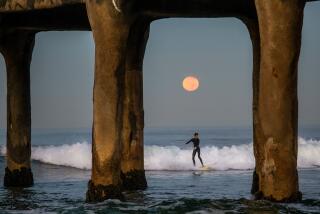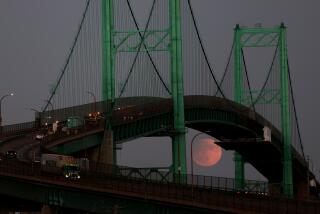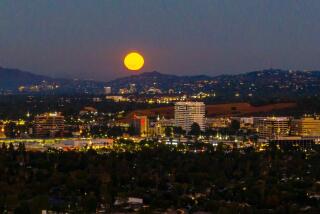Blue moon: Wink at tonight’s moon in tribute to Neil Armstrong
A blue moon arrives on the same day that Neil Armstrong, the first man to walk on the moon, was laid to rest. Coincidence?
It could be argued that the heavens -- and Armstrong’s family, friends and many fans -- think not. In announcing Armstrong’s death last week at the age of 82, his family asked: When people “see the moon smiling down at you, think of Neil Armstrong and give him a wink.”
The humble space cowboy who never capitalized on his celebrity was laid to rest at a private service Friday in suburban Cincinnati, according to the Associated Press. Also occurring Friday: a so-called blue moon, a rare lunar event in which two full moons occur during a single calendar month.
The last time a blue moon occurred was December 2009. The next time will be July 2015.
Now, the blue moon is not actually blue. (The moon, of course, always stays the same color.) That said, don’t be surprised if the moon actually has that cool, jewel-toned hue when you look up at it this evening. The moon can appear to change color due to disruptions on a massive scale; debris from forest fires, or a plume of volcanic ash, can visually affect the way the moon appears to us.
When the moon takes on reddish hues, it can be called a “blood moon”; when it appears more golden in tone, a “honey moon.” Professor Bill Kreiger, a professor of earth sciences and science education at York College, told the Evening Sun that wildfires in the Western U.S. could indeed make for a blue moon that actually looks blue.
The term “blue moon” is actually up for debate, believe it or not. Some space types say its provenance is not certain. The newest issue of Sky & Telescope contends the term stems in part from an error made in its pages, and then repeated.
But we digress.
Stephen Edberg, an astronomer at NASA’s Jet Propulsion Laboratory, told the Los Angeles Times that the best time to glimpse this rare lunar event is not late at night but right when the moon starts to rise, around 7:13 p.m. Ideally, viewers should find an eastward-facing spot with a clear look at the horizon.
He said viewers will be treated to an experience that is like a sunset in reverse. Or, like a sunrise that doesn’t require squinting in an attempt to avoid permanent damage to the eyes.
“The rising moon, if you see it on the horizon, it’s a neat opportunity,” Edberg said.
Edberg said he’s gotten a kick out of all the excitement the blue moon has caused among the lay public. Among astronomers, it’s little more than a quirk of the calendar. The lunar cycle is 28 to 29 days long, while the average month is about 30 days long. Over time, the two cycles fall out of sync to such a degree that a so-called blue moon occurs.
“But I’m just happy that people are interested enough to look up at the sky and realize there’s more to our universe than what is at eye level,” he said. “That’s a good thing.”
And when you look up tonight, remember to pay a moment’s tribute to the ultimate man in the moon, Neil Armstrong.
ALSO:
Blue moon: Best time to watch for it Friday night
Shell oil: Arctic drilling could begin next week in Chukchi Sea
Washington, D.C. security guard admits trying to sell secrets to China
More to Read
Sign up for Essential California
The most important California stories and recommendations in your inbox every morning.
You may occasionally receive promotional content from the Los Angeles Times.











